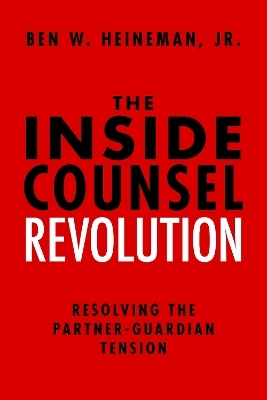
The Inside Counsel Revolution
American Bar Association (Verlag)
978-1-63425-279-9 (ISBN)
- Titel z.Zt. nicht lieferbar
- Versandkostenfrei innerhalb Deutschlands
- Auch auf Rechnung
- Verfügbarkeit in der Filiale vor Ort prüfen
- Artikel merken
Inside Revolution: Resolving the Partner-Guardian Tension, provides a
thoughtful and thought provoking analysis of the role General Counsels, and
lawyers more generally, can and should play in business and society.
In the past 25 years, there has been a revolution in
the legal profession. General Counsel and other inside lawyers have risen in
quality, responsibility, power and status. Once second-class citizens in
corporations and the legal profession, they have become core members of top
corporate management, equaling in importance the Chief Financial Officer and
the finance function. They have dramatically shifted power from law firms to
corporate law departments, assuming strategic direction over legal matters and
exercising far greater control over law firm billing and economics.
Ben W. Heineman, Jr. has led that revolution in his
nearly 20 years as the top lawyer at GE and then in teaching and writing as a
Distinguished Senior Fellow at Harvard Law School’s Program on the Legal
Profession and lecturer at Yale Law School. In this analytic and prescriptive
book, he describes the essence of that transformation and the modern role of
inside counsel: the key functions, relationships, issues, problems and
dilemmas. Moreover, he argues for the role of inside counsel as
lawyer-statesman, motivated not just by the desire for income but by broader
values of integrity and corporate citizenship.
In this analytic and prescriptive book, he describes
the essence of that transformation and the modern role of inside counsel in
helping attain the corporate mission of high performance with high integrity:
the key functions, relationships, issues, problems and dilemmas. He argues for
the role of inside counsel as lawyer-statesman and as a partner of the CEO but
also guardian of the corporation, motivated not just by the desire for income
but by broader values of integrity and corporate citizenship.
The Inside Counsel Revolution is a
succinct, concrete yet visionary statement of first principles from a highly
regarded founder of the in-house revolution that fundamentally changed the
legal profession and reframed the lawyer-statesman role in this era to serve
the performance, integrity and risk goals of global capitalism.
Published by the American Bar Association in April 2016.
Benjamin W. Heineman Jr. is GE's former senior vice-president for law and public affairs and is currently a senior fellow at Harvard Law School and at Harvard's Kennedy School of Government.
Part One: The
General Counsel as Partner and Guardian 1
Chapter 1 Introduction: The
Inside Counsel Revolution 3
a. Transformation 3
b. Credit Where Credit Is Due 8
c. Causes: A Schematic View 10
d. The Prescriptive Perspective
15
e. Core Concepts and Key Issues
21
Chapter 2 The Lawyer-Statesman
Ideal 23
a. Overview: Is It Legal? Is It
Right? 23
b. Historical Traditions 26
c. Outstanding Expert, Wise
Counselor, and Accountable Leader 31
d. “Complementary” Competencies:
Beyond the “Core” 41
e. Analysis before Recommendation
46
f. Analysis before Advocacy 51
G. An Important Conscience of the
Corporation 53
Chapter 3 Partner-Guardian
Realities 55
a. The Tension 55
b. The Fusion 58
c. The Obstacles 63
d. The General Counsel’s
Character, Reputation, and Identity 68
e. Protecting Other Inside
Counsel 71
f. Alliance with Other Staff
Functions 74
g. The Board of Directors 75
h. The CEO 81
i. Dealing Directly with CEO Risk
83
Chapter 4 The Cultural Imperative
91
a. Primacy 91
b. The Pressures That Corrupt 95
c. Imposing Discipline 108
d. Letting Employees Speak—and
Then Listening 115
e. An Integrity “Learning
Culture” 121
f. Financial Rewards 125
g. Assessing Culture 127
Part Two: Key
Issues 129
Chapter 5 Compliance and Legal
Hazard: The Essence 131
a. Complexity 132
b. Regulatory Trends 135
c. Determining What Is the Law
140
d. The CEO as Chief Compliance
Officer 142
e. Prevent, Detect, and Respond
144
f. Deals 159
g. Value of a Good Compliance
System: Morgan Stanley 161
h. Value of a Good Response to
Compliance Disaster: Siemens 163
i. GC, CFO, and Chief Compliance
Officer: Function Not Form 168
j. People and Resources:
Platinum, Gold, Silver, Bronze—or Nickel 176
Chapter 6 Ethics: The Complexity 183
a. Identifying Ethical Issues 185
b. Setting Ethical Standards 188
c. Challenges in Global Supply
Chains 197
d. Conflict between Global
Standards and National Law 213
e. Ethical Problems When There Is
No National Enforcement 219
f. Exiting Rogue States 222
g. Cost: Small and Medium-Sized
Companies 226
h. Values 226
Chapter 7 Risk and Crisis
Management 229
a. Scope 230
b. Organizational Principles 232
c. Framework Questions 236
d. Catastrophic Events and Crisis
Management 244
e. Fukushima: Debating Disaster
249
f. BP and the Gulf: “Exhibit A”
for Catastrophic Costs of Failure 253
g. A Comment on Geopolitical,
Terrorism, and Cyber Risk 264
h. The Need for Specialized
Knowledge 270
Chapter 8 Governance: The Board
Relationship 275
a. The Three Dimensions of
Governance 276
b. The Framework of Formal Rules
278
c. The Six Essential Tasks of
Board–Management Leadership 280
d. Special Problem: Executive
Compensation 300
e. Board Independence and
Leadership 307
f. Shareholders: Stewards and
Activists 310
Chapter 9 Citizenship and the
Primacy of Public Policy 317
a. Philanthropy 319
b. Business Activities 322
c. Collective Action:
Anticorruption 326
d. Public Policy 335
e. Reporting 354
f. Reputation 357
Part Three:
The Global Legal Organization in the Future 359
Chapter 10 Leading the Law
Department 361
a. Mission 361
b. Hire the Best 363
c. Delegation 371
d. Accountability: Centralized or
Decentralized Model 374
e. Global Integration 380
f. Duties to Inside Lawyers 382
g. Innovation, Management, and
Cost 390
h. Explaining the Legal
Organization to Business Leaders 398
Chapter 11 Law Fi rms—and
Alternatives 401
a. Problems: A Brief Bill of
Particulars 402
b. Solutions: A Brief History 406
c. The Primacy of Segmentation
411
d. Rethinking Resource Allocation
412
e. Resetting the Relationship 417
f. Cooperation on Ethics 428
g. A Personal Note 438
Chapter 12 The Future: Problems
and Possibilities 441
a. Extending the GC’s Reach 442
b. Attitudes: Boards of
Directors, CEOs, and Business Leaders 444
c. Making the Case That Cost
Creates Value 447
d. Going Global? 450
e. Partner and Guardian 454
NOTES 457
Acknowledgments 491
About the Author 493
INDEX 495
Part one
| Erscheint lt. Verlag | 15.8.2023 |
|---|---|
| Zusatzinfo | Illustrations |
| Verlagsort | Chicago, IL |
| Sprache | englisch |
| Maße | 152 x 228 mm |
| Themenwelt | Recht / Steuern ► Allgemeines / Lexika |
| Recht / Steuern ► EU / Internationales Recht | |
| Recht / Steuern ► Öffentliches Recht | |
| Recht / Steuern ► Privatrecht / Bürgerliches Recht ► Berufs-/Gebührenrecht | |
| Recht / Steuern ► Wirtschaftsrecht ► Bank- und Kapitalmarktrecht | |
| Wirtschaft ► Betriebswirtschaft / Management ► Unternehmensführung / Management | |
| ISBN-10 | 1-63425-279-9 / 1634252799 |
| ISBN-13 | 978-1-63425-279-9 / 9781634252799 |
| Zustand | Neuware |
| Informationen gemäß Produktsicherheitsverordnung (GPSR) | |
| Haben Sie eine Frage zum Produkt? |
aus dem Bereich


